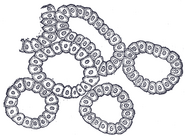Assessment |
Biopsychology |
Comparative |
Cognitive |
Developmental |
Language |
Individual differences |
Personality |
Philosophy |
Social |
Methods |
Statistics |
Clinical |
Educational |
Industrial |
Professional items |
World psychology |
Biological: Behavioural genetics · Evolutionary psychology · Neuroanatomy · Neurochemistry · Neuroendocrinology · Neuroscience · Psychoneuroimmunology · Physiological Psychology · Psychopharmacology (Index, Outline)
| Alveolar gland | ||
|---|---|---|
| Section of pancreas of dog. X 250. | ||
| Latin | ' | |
| Gray's | subject # | |
| System | ||
| MeSH | [1] | |
| Centroacinar cells | ||
In contrast to tubular glands, in the second main variety of gland, the secretory portion is enlarged and the lumen variously increased in size. These are termed alveolar glands[1] (or saccular glands[2], or acinar glands[3], or acinous glands[4]).
Some sources draw a clear distinction between acinar and alveolar glands, based upon the shape of the lumen.[5]
A further complication in the case of the alveolar glands may occur in the form of still smaller saccular diverticuli growing out from the main sacculi. These are termed alveoli.
The term "tubulo-alveolar" (or "tubulo-acinar", or "compound tubulo-acinar", or "compound tubulo-alveolar"[6]) is used to describe that start out as branched tubular, and branch further to terminate in alveoli. This type of gland is found in the salivary glands[7], esophagus[8], and mammary glands.
The term "racemose gland"[9] is used to describe a "compound alveolar gland" or "compound acinar gland".[10]
Nervous system control of these glands[]
Additional images[]
See also[]
- Acinus
- Duct (anatomy)
References[]
- ↑ Dictionary at eMedicine Alveolar+gland
- ↑ Dictionary at eMedicine Saccular+gland
- ↑ acinar
- ↑ Dictionary at eMedicine Acinous+gland
- ↑ Blue Histology - Epithelia and Glands
- ↑ Template:KansasHistology
- ↑ Template:KansasHistology "Compound Tubulo- Alveolar"
- ↑ MedEd at Loyola histo/practical/epithelium/hp1-28.html
- ↑ Dictionary at eMedicine Racemose+gland
- ↑ SIU SOM Histology GI
Histology: Epithelial tissue (TH H2.00.02) | |||||||||||||||
|---|---|---|---|---|---|---|---|---|---|---|---|---|---|---|---|
| Epithelial cells |
| ||||||||||||||
| Surface epithelium |
| ||||||||||||||
| Gland/ glandular epithelium |
| ||||||||||||||
;See also
| |||||||||||||||
| This page uses Creative Commons Licensed content from Wikipedia (view authors). |

